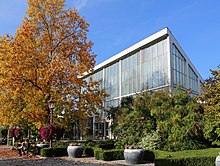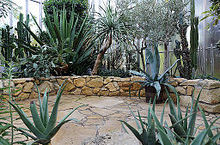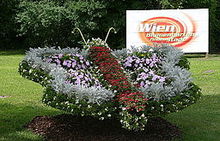Hirschstetten flower gardens
The Hirschstetten flower gardens (formerly Hirschstetten reserve gardens ) in Quadenstrasse in the 22nd district of Donaustadt belong to the Municipal Department (MA) 42 - Vienna City Gardens of the City of Vienna .

The plants needed for public planting have been grown in the Hirschstetten flower gardens since the 1950s. Since the production of the plants became more and more superfluous through purchase, it was decided to redesign the areas and open them to visitors. The facility has been open between mid-March and mid-October since 2002 and is used as a recreational area. In the publicly accessible complex, in addition to the palm house in the 60,000 m 2 florarium, themed show gardens ("Donaustädter Weinhügel", "Garden of Provence", "Chinese or TCM garden", "Primeval garden"), a modeled traditional farm and several small zoological areas (wild cat enclosure, goats on the farm, turtle garden, insectarium in the palm house) can be visited.
history
In 1860, the city of Vienna acquired the garden center of the Bechard-Palais (today the location of the Weißgerberkirche ) in order to be able to grow the plants required for the urban gardens. Between 1867 and 1868 a new location was moved to the Heumarkt in the area of today's Vienna Ice Skating Club , which was given up in 1896/1897 in favor of the new address Vorgartenstraße 158-170 (or Ennsgasse 12) in Vienna-Leopoldstadt due to the Vienna river regulation .
On the 46,000 m 2 available area there were hotbeds , 25 glass houses and a palm house (built in 1904) in which the potted plants used for urban representation events were overwintered. In July 1914, it was decided to finance the construction of a building that was supposed to house the poultry of municipal park ponds out of season.
Another, with 71,300 m 2 significant urban investment was the Reserve Garden Kagran (Ziegenhäufl) , today: school garden Kagran with the existing since 1977 Austrian Horticultural Museum in the house Siebeck road 14. The parts before the First World War from city garden director Wenzel Hybler (1847 to 1920) The Kagran reserve garden was particularly important in the war and post-war period, as the poor supply situation for the residents of Vienna required training in the cultivation and rearing of vegetables and fruit trees; In 1915 vegetable seedlings were given to the population free of charge, albeit on a modest scale; in 1916 there were already 1.6 million. In 1923, the municipal administration left the reserve garden to the allotment garden of the City of Vienna GmbH , combined with the order to create a production facility for fruit trees , since, according to an estimate, there was space for over 300,000 fruit trees in Vienna's gardens alone. A few years later the facility passed into the possession of the Viennese advanced training council, who converted the business into a horticultural school.
Before the end of the Second World War, there were two large municipal market gardens and six smaller glass houses in Vienna.
With the takeover of the property in Quadenstrasse, the Vienna City Planning Department began planning work for the new municipal nursery.
The reasons for the gradual relocation to Hirschstetten from 1957 onwards were the severe war damage to the facility in Vorgartenstrasse and also the exhaust gases from the nearby steam power station in Engerthstrasse . At the same time, with this measure, various small nurseries were closed, so that only the two large locations in Hirschstetten and the former Rothschild gardens on the Hohe Warte remained. The new front garden market and residential houses were built on the previous location.
A branch has existed in Hänischgasse in Eßling since 1982 .
In September 2002, the original name was Reserve Garden Hirschstetten on flower gardens Hirschstetten changed. Visitors can visit the facility from April to October; the palm house remains open during the winter months.
Prominent visitors
In 1958 the Austrian Minister Oskar Helmer visited the reserve garden, in June 1963 the Indonesian President Sukarno and Mayor Franz Jonas - who received two bananas ripened in the reserve garden as a gift in August of the same year - were guests.
investment

The most modern urban nursery in Europe at the time of its construction covered an area of 18 hectares
- 24 culture houses measuring 6 meters × 22 meters,
- 3 glass houses measuring 8 meters × 22 meters,
- 3 glasshouse block systems with 27 naves,
- 1 large greenhouse (palm house) with three sections. These are connected with each other with connecting corridors, which can also be used by trucks.
In addition to the 9,629.5 square meters built in this way, around 8,000 square meters of hotbeds were added.
Furthermore, two hibernation houses for cold house plants, two pot houses for storing flower pots, a house for servants, a guest house for gardeners from abroad, a staff building and stables in which water birds from Vienna's parks (flamingos, pelicans, herons, storks) were built , Swans and ducks) were built during the winter.
The technical equipment of the Hirschstetten reserve garden also included a heat pump , which was the second such system in Vienna after the Theresienbad in Meidling .
Florarium
The so-called florarium covers an area of 60,000 m 2 with numerous themed gardens with both native and other plants from other regions such as palm trees, citrus trees and many more. as well as water gardens and a maze of privet hedges.
Palm house
In the palm house, flora and, to a small extent, fauna from three climatic zones are presented in three areas on 700 m 2 . The central area, which also includes a pond and a waterfall, shows plants from tropical regions, the two side tracts on the one hand plants from the Mediterranean region , on the other hand the so-called palm grove.
Zoological facilities

There have also been animals in the Hirschstetten flower gardens since the 1970s, and in 2006 an application was made for animal welfare approval, which was also granted. Since then, the zoological garden in Hirschstetten has had a category A permit, as has the Schönbrunn zoo.
The palm house houses enclosures with northern shrews and rock guinea pigs as well as several insectariums and terrariums . Birds such as ostrich quail , Ganges-eyed birds and the like live among the plants. a.
In the florarium there are enclosures for lizards, crested newts, fire salamanders and a couple of wild cats , the turtle garden and on the farm an area for goats and one for sheep. Ground squirrels originally kept in their own enclosure have quickly spread over large parts of the area and now inhabit a. the wine hill. In recent years there has also been a breeding program for the Ural Owl, whose adult young are released into the wild every year.
power
Four times a year in Vienna there is fresh planting of green areas in parks, planters at various locations and on traffic islands.
Between February and March around 260,000 spring flowers (mostly primroses ), around 1,200,000 summer flowers between May and September and around 50,000 plants that bloom in autumn ( e.g. chrysanthemums , heather and cabbage ) are planted between May and September , which in addition to plants from the branch in Eßling come mainly from the Hirschstetten flower gardens. There are also around 50,000 perennial flowering shrubs that also come from the Hirschstetten flower gardens.
Another task of the flower gardens is the plant-based equipment of office buildings, schools and hospitals, of balls of the city of Vienna, but also of presentation and information events of the city of Vienna.
In times of crisis, the Hirschstetten reserve garden should be used to produce vegetables for Vienna's hospitals, kindergartens and other welfare institutions.
Events
The Hirschstetten flower gardens are also the setting for various events. For example, special flower shows (orchid shows, ...), exhibitions with local interest and a Christmas show with a Christmas market take place.
The palm house can also be rented for events. In addition, the Rosarium and the Palm House are popular venues for wedding ceremonies.
literature
- Das neue Wien, Städtewerk, published with the official cooperation of the Municipality of Vienna , Vienna, 1927
- Reserve garden of the City of Vienna - Hirschstetten , Vienna, 1961
- Hirschstetten flower gardens in the Vienna History Wiki of the City of Vienna
- A suburb of flowers . In: Arbeiter-Zeitung . Vienna May 9, 1956, p. 4 ( berufer-zeitung.at - the open online archive - digitized).
- The lilacs bloom in Hirschstetten . In: Arbeiter-Zeitung . Vienna January 9, 1966, p. 3 ( berufer-zeitung.at - the open online archive - digitized).
Web links
- Hirschstetten Flower Gardens of the City of Vienna - officially , accessed on February 3, 2009.
- Hirschstetten Flower Gardens - Florarium & Rosarium, photo set on flickr
Individual evidence
- ↑ On the day. (...) To promote vegetable growing. In: German press. Newspaper for Pan-German Politics , No. 72/1915 (Volume II), March 30, 1915, p. 3, right. (Online at ANNO ). .
- ↑ Daily news. (...) Viennese war vegetable gardens. Sale of vegetable plants by the municipality. In: Oesterreichische Volks-Zeitung , No. 187/1916 (LXII. Year), July 8, 1916, p. 6, bottom left. (Online at ANNO ). .
- ^ Vienna - the center of the Austrian fruit tree culture. In: Arbeiter-Zeitung , Morgenblatt, No. 87/1923 (XXXV. Year), March 30, 1923, p. 7, bottom center. (Online at ANNO ). .
- ↑ Max Winter : Pineapple Strawberries and Mine Throwers. A walk through the school for gardeners' apprentices. In: Arbeiter-Zeitung , Morgenblatt, No. 109/1930 (XLIII. Volume), April 20, 1930, p. 11, top center. (Online at ANNO ). .
- ↑ a b glass houses, heated with cold water . In: Arbeiter-Zeitung . Vienna September 8, 1957, p. 8 ( berufer-zeitung.at - the open online archive - digitized).
- ↑ http://www.wien.gv.at/rk/historisch/1961/juli.html accessed on February 3, 2009
- ↑ http://www.wien.gv.at/vtx/vtx-rk-xlink?SEITE=%2F2002%2F0906%2F009.html accessed on February 3, 2009
- ↑ http://www.wien.gv.at/rk/historisch/1958/mai.html accessed on February 3, 2009
- ↑ http://www.wien.gv.at/rk/historisch/1963/juni.html accessed on February 3, 2009
- ↑ http://www.wien.gv.at/rk/historisch/1963/august.html accessed on February 3, 2009
- ↑ Hirschstetten flower gardens: Palm house in the Hirschstetten flower gardens , accessed on December 2, 2014
- ↑ Hirschstetten flower gardens: Hirschstetten Zoological Garden , accessed on December 2, 2014
- ↑ http://www.wien.gv.at/umwelt/parks/statistik.html accessed on February 3, 2009
- ↑ Hirschstetten Flower Gardens , accessed on February 1, 2016
- ↑ Blooming reservoir of the big city. In the reserve garden of the municipality of Vienna . In: Arbeiter-Zeitung . Vienna June 11, 1958, p. 7 ( berufer-zeitung.at - the open online archive - digitized).
- ↑ http://www.wien.gv.at/vtx/vtx-rk-xlink?SEITE=%2F1994%2F0210%2F008.html accessed on February 3, 2009
- ↑ http://www.wien.gv.at/vtx/vtx-rk-xlink?SEITE=%2F1996%2F0829%2F009.html accessed on February 3, 2009
- ↑ http://www.wien.gv.at/umwelt/parks/blumengaerten-hirschstetten/index.html accessed on February 3, 2009
Coordinates: 48 ° 14 ′ 16.7 " N , 16 ° 28 ′ 23.8" E







